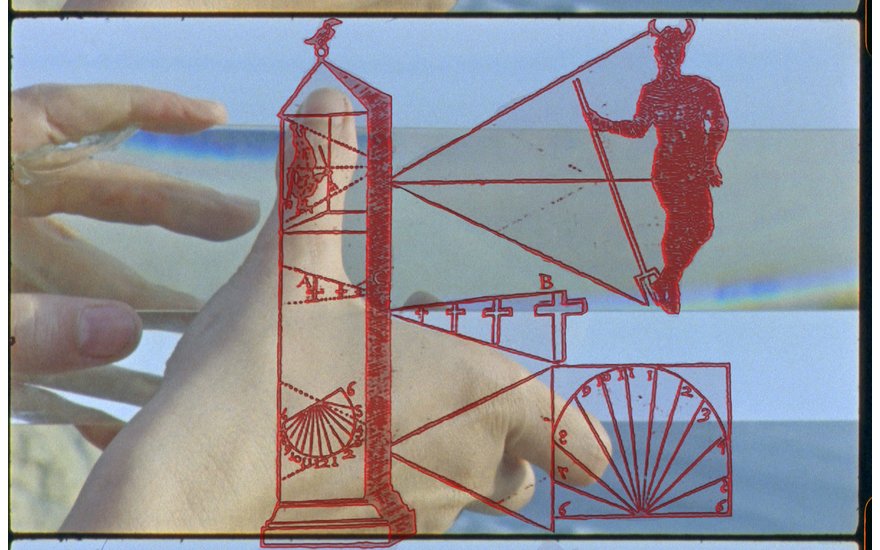선스톤 SUNSTONE_루이스 핸더슨 & 필리파 세자르 LOUIS HENDERSON & FILIPA CÉSAR





선스톤 SUNSTONE_루이스 핸더슨 & 필리파 세자르 LOUIS HENDERSON & FILIPA CÉSAR
UK, Portugal, Belgium / 2018 / Color / Sound / 34min / HD
Description
이 작품은 프레넬 렌즈를 그 생산지로부터 등대와 항법장치를 전시하는 박물관에 이르기까지 추적한다. 또한 이 작품은 광학과 관련된 다양한 사회적 맥락을 살펴보면서 최초의 유럽인이 ‘신세계'에 도착한 이후에 등장한 삼각무역 체계와 혁명 이후 쿠바에서의 옵아트의 정치적 잠재력을 비교한다. 16mm 셀룰로이드 이미지와 바탕화면의 디지털 캡처, 그리고 3D CGI를 결합시키면서 이 작품은 하나의 기술적 궤적을 그려낸다. 광학적 항법의 역사적 방법들에서 위치확인의 새로운 알고리즘에 이르기까지, 그리고 단일 원근법에서 위성 촬영에 이르기까지.
어둠 속에 빛을 비추는 인공물로서의 등대는 근대성의 계몽주의 기획의 욕망을 완벽하게 압축하고 있다. 이성에 의한 자연의 지배, 지구적 규모에서의 기술과 무역의 발전, 유럽 기독교 윤리의 투명성은 모두 어둠 속의 등대라는 상징에 들어맞는다. 이 작품은 광학 항법에서 출발하여 위치확인 알고리즘에 이르는 표류기이다. 다양한 렌즈와 장치, 그리고 기술을 활용하여 만들어진 이 작품으로부터 우리는 프레넬 렌즈의 물적 생산에서부터 등대의 종말을 고한 GNSS(전지구적 위성항법시스템)에 이르는 여정을 항해할 것이다.
GNSS는 인간의 공간에 대한 지각, 시각의 힘, 그리고 지도제작 능력을 변화시켰으며, 세계에 관한 새로운 이미지를 창조하였다. 이 새로운 지도제작 체계는 새로운 유형의 권력과 통제로부터 나왔다. 등대와 함께 대서양을 가로지르는 항해가 증대되었다면 GNSS는 교역이 상품에서 데이터로 이전된다는 점을 보여준다. GNSS는 군사, 민간, 상업 영역뿐만 아니라 사적 공간과 공적 공간이 네트워크로 연결되고 중첩되는 시대의 산물이다. 등대는 의식의 해변에 남아서 사유를 지속시킨다. 그리고 GNSS는 더 멀리 항해해 나간다.
Sunstone tracks Fresnel lenses from their site of production to their exhibition in a museum of lighthouses and navigational devices. It also examines the diverse social contexts in which optics are implicated, contrasting the system of triangular trade that followed the first European arrivals in the ‘New World’ with the political potential seen in Op art in post-revolutionary Cuba. Incorporating 16mm celluloid images, digital desktop captures and 3D CGI, the film also maps a technological trajectory: from historical methods of optical navigation to new algorithms of locating, from singular projection to multi-perspectival satellitic visions.
The lighthouse, as a man-made object built to shed light into the dark unknown, encapsulates perfectly the desires of the Enlightenment project of modernity: the domination of nature through reason and intellect, the advancement of technology and trade on a global scale, the illuminatory transparency of European Christian morality – a beacon in the dark. This 'op-film' will be a disorienting and disoccidenting dérive from optical navigation to algorithms of locating – an essay against the grain of Western patterns of referencing and situating. From a film made with lenses and photosensitive celluloid to the desktop locating engine, we will navigate from the material production of Fresnel lenses to the invention of global navigation satellite systems (GNSS) – the tool that announces the obsolescence of the lighthouse.
GNSS alters human perception of space, powers of vision, and cartographic capabilities, and create new images of the world. With this new system of mapping come new forms of power and control. If the lighthouse signals a growth in transatlantic transportation, then satellite systems signal the transfer of the material substrate of commerce from goods to data. GNSS is born in an age of the networked interpolation of military space, civic space, commercial space, private space, and public space. The lighthouse remains on the shores of consciousness as a form of thinking – GNSS navigates it further.'
Interview with artist / filmmakers Filipa César and Louis Henderson about their collaborative exhibition at Gasworks, 'Op-Film: An Archaeology of Optics' (27 April - 25 June 2017).

